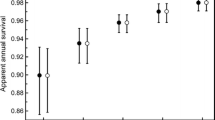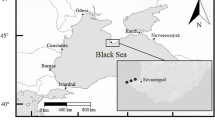Summary
An analysis for an age-structured demography was conducted to explore the sensitivity of fitness to individual parameters of a growth equation (Brody-Bertalanffy) and a survivorship function (Weibull). Initial parameters were selected to simulate populations of sea urchins and include northern and southern populations of the temperate sea urchin Strongylocentrotus purpuratus and tropical species such as Diadema antillarum. Results of the analysis are intuitively reasonable. Regardless of whether a population is increasing or decreasing, there would always be an increase in fitness associated with increases of: 1) the growth-rate constant, 2) maximum gonad size, 3) maximum lifespan, 4) the shape parameter of the Weibull function; and, decreases of 1) the age at first reproduction and 2) the ratio of number of recruits/spawn weight. If trade-offs are possible then improved survival characteristics and increased lifespan would be favored in declining populations. In general, relative sensitivity is dependent upon which parameter is varied in the simulations. The analysis shows which changes of parameters would bring about the greatest change in fitness but can not show trade-offs or design constraints. An example of trade-off in urchin life history is the relationship between the growth-rate constant, K and maximum lifespan, ω. A doubling of lifespan is associated with a halving of K.
Similar content being viewed by others
References
Baker S (1973) Growth of the red sea urchin Strongylocentrotus franciscanus (Agassiz) in two natural habitats. MS Thesis. San Diego State Univ., San Diego, CA. 83 pp
Beverton RJH, Holt SJ (1959) A review of the lifespans and mortality rates of fish in nature, and their relation to growth and other physiological characteristics. Ciba Foundation Colloq. Aging 5:142–180
Buchanan JB (1966) The biology of Echinocardium cordatum (Echinodermata: Spatangoidea) from different habitats. J mar biol Ass UK 46:97–114
Caswell H (1982a) Life history theory and the equilibium status of populations. Am Nat 120:317–339
Caswell H (1982b) Optimal life histories and the maximization of reproductive value: A general theorem for complex life cycles. Ecology 63:1218–1222
Caswell H (1982c) Stable population structure and reproductive value for populations with complex life cycles. Ecology 63:1223–1231
Caswell H, Werner PA (1978) Transient behavior and life history analysis of teasel (Dipsacus sylvestris Huds.). Ecology 59:53–66
Cole LM (1954) The populations consequences of life history phenomena. Q Rev Biol 29:103–137
Ebert TA (1968) Growth rates of the sea urchin Strongylocentrotus purpuratus related to food availability and spine abrasion. Ecology 49:1075–1091
Ebert TA (1975) Growth and mortality of post-larval echinoids. Am Zool 15:755–775
Ebert TA (1982) Longevity, life history, and relative body wall size in sea urchins. Ecol Monog 52:353–394
Ebert TA (1983) Recruitment in echinoderms. In: “Echinoderm studies. vol. 1” (ed. Jangoux M, Lawrence J), AA Balkema, pp 169–203
Fuji AR (1963) On the growth of the sea urchin Hemicentrotus pulcherrimus (A. Agassiz). Bull Jap Soc Sci Fish 29:118–126
Goodman D (1982) Optimal life histories, optimal notation, and the value of reproductive value. Am Nat 119:803–823
Jensen M (1969) Breeding and growth of Psammechinus miliaris (Gmelin). Ophelia 7:65–78
Leslie PH (1945) On the use of matrices in certain population mathematics. Biometrika 33:185–212
Lewis JB (1966) Growth and breeding in the tropical echinoid Diadema antillarum Philippi. Bull Mar Sci 16:151–158
McPherson BF (1965) Contributions to the biology of the sea urchin Tripneustes ventricosus. Bull Mar Sci 15:228–244
McPherson BF (1968) Contributions to the biology of the sea urchin Eucidaris tribuloides (Lamarck). Bull Mar Sci 18:400–443
Miller RJ, Mann KH (1973) Ecological energetics of the seaweed zone in a marine bay on the Atlantic coast of Canada III. Energy transformations by sea urchins. Mar Biol 18:99–114
Moore HB (1935) A comparison of the biology of Echinus esculentus in different habitats. Part II. J mar biol Ass UK 20:109–128
Murphy GI (1968) Pattern in life history and the environment. Am Nat 102:391–403
North WJ (1965) La Jolla. In: “Annual report, 1 February 1964–31 March 1965. Kelp habitat improvement project.” WM Keck Laboratory of Environmental Health Engineering. Cal Inst Techn, pp 25–32
Poole L, Borchers M (1977) Some common BASIC programs 3rd ed. Osborne/McGraw-Hill, 195 pp
Randall JE, Schroeder RE, Starck WA (1964) Notes on the biology of the echinoid Diadema antillarum. Caribbean J Sci 4:421–433
Ricker WE (1973) Linear regression in fishery research. J Fish Res Bd Canada 30:409–434
Schaffer MW (1974) Optimal reproductive effort in fluctuating environments. Am Nat 108:783–790
Schmidt KP, Lawlor LR (1983) Growth rate projection and life history sensitivity for annual plants with a seed bank. Am Nat 121:525–539
Sterns SC (1976) Life history tactics: a review of the ideas. Quart Rev Biol 51:3–47
Stearns SC (1977) The evolution of life history traits: a critique of the theory and a review of the data. Ann Rev Ecol Syst 8:145–171
Author information
Authors and Affiliations
Rights and permissions
About this article
Cite this article
Ebert, T.A. Sensitivity of fitness to macroparameter changes: an analysis of survivorship and individual growth in sea urchin life histories. Oecologia 65, 461–467 (1985). https://doi.org/10.1007/BF00379658
Received:
Issue Date:
DOI: https://doi.org/10.1007/BF00379658




